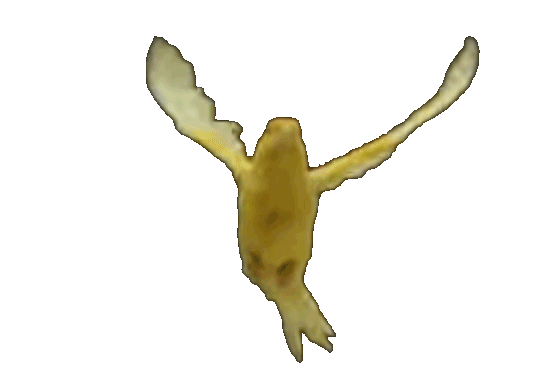When I was 15 I had to slice up cows’ eyes for biology class. We had to categorize and label the resulting squishy goo. Impressed with the obligatory scissoring I questioned the endeavour. Why should we do this? To confirm the words and illustrations in the next chapter of the book.
Scissors snap vigorously, and words slither in weaving stuff back together. On the scissor end: biology; on the weaving end: semiotics. The ends are far apart, and strolling in between is often perceived as heresy or stuff for churches. Smuggling concepts from one end to the other is frowned upon, mostly because the vocabulary is not shared. As the obsessive efficiency-motivated scissoring continues words are created indefinitely. Pieces shouldn’t go unnamed.
Le Guinn said in her carrier bag theory of fiction, that we are ‘amid alien corn’. And I think we owe a bunch of history to the foreign seeds and smuggled ideas that got to terra incognita. The smugglers’ path often lies along the fine line between the absurdly naive and the frightening complex. A euclidian line from here to the place that says ‘hic sunt dracones‘.
I sliced nicely along the illustrated dotted lines with the polished steel dissection knife trying not to get distracted by the mirrored the globby goo. I got lost in some of the reflections, and repetition of structures. Following the dotted line led to a bunch of gooey pieces and clearly distinct words such as ‘lens’ and ‘retina’ and ‘optic nerve’ (no note of the squishy noises). The words pretended to have clear, straight outlines, but they felt just as gooey as their signified other. When I cut away the lens from its surroundings it became utterly useless, when the very word loses its context – the biology lesson – it becomes so abstract is practically meaningless. This left me wondering about the similarities between material stuff and semiotic units. I wondered about dotted lines. I wondered about eyes and dragons.
Wholes are made of parts, and above all: repetition legitimizes.
It doesn’t seem too farfetched to me that we have an innate interest in those things. You know, those things that copy themselves and mutate only to gain chances at reproducing – the things that puncture and slice – tools. This project I am undertaking is a study of the similarity between tool and subject. In the project I focus on evolutionary principles that run parallel between subjects now studied in vastly different disciplines. My main interest is the use of genetic algorithms and sound synthesis to create a meaningful vocabulary for my canary, which arouses him in any form. As opposed to behavioural Pavlovian techniques based in the material, I focus on intrinsic motivation for code-based communication.
Music, language, science or life: repetition legitimizes.
I focus on a canary’s bird song. It is a way to talk about language in a way that anthropocentrists don’t get offended (and oh boy do people get offended when you question their reserved first place in chains of causality). I perceive bird song as an intermediary between language and music, which might reveal things about both or the gooey stuff masquerading as a clear, straight border in between. Leaving some nuance behind, Darwin told us birds are but far cousins. I can’t help but see countless similarities between different loudly chirping peacocking bipeds (give or take a few feathers). The beauty in the diversity of colour and sound, but also the brutish puncturing tendencies that go hand in hand.
In the following posts, you’ll find a technical explanation of the algorithmic systems I’ve developed. The systems mostly make inquiries about the usefulness of genetic algorithms in meaningful audio generation or generation of semiotic signifiers. I alternate these technicalities with thoughts about broader implications this mode of thought has on the thing we call ‘culture’. This project engages in an exploration of the intersection between biology, ecology, semiotics, acoustics, information theory and artificial life or intelligence, because I firmly believe, hic sunt dracones.
